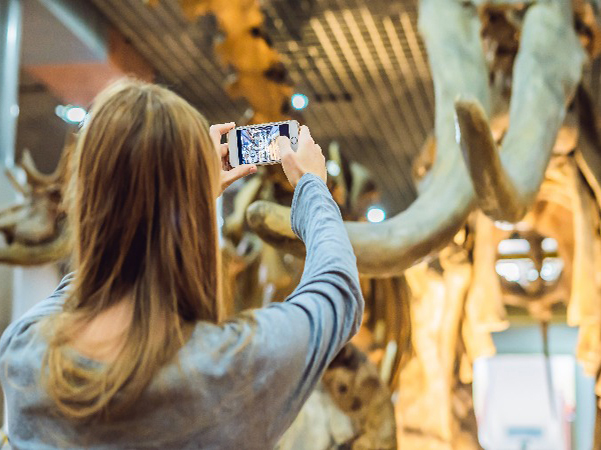
The idea of storytelling is one that’s age-old.
From the spoken word to magnificent works for art and literature to today’s digital experiences, the art of storytelling has always evolving. In many museums across the globe, a new iteration of storytelling is being implemented – and layered – onto other mediums.
As mobile phones have become ubiquitous, museums are using augmented reality (AR), virtual reality, and mixed reality to enhance visitor experiences and create richer exhibits. With AR, visitors are engaging with immersive art and entire exhibits in new and novel ways.
Like in factories, where just-in-time learning is increasing being adopted for training use cases, these types of technologies provide an improved learning experience, one that delivers information in-context, reduces cognitive distance, and increases retention.
A Wired article described the use of AR in museums in this way: “Traditionally, the museum experience was one-directional: Curators conceived of and executed an exhibit, which visitors then enjoyed. Now, that’s all starting to change.”
Since one of the primary objectives of museums is education, it’s to the benefit of all involved to enable a learning experience that’s bi-directional, where the learner can actively participate in his own knowledge gathering. AR is a medium that creates opportunity for a more interactive, layered, and immersive experience.
Let’s take a look at some examples.
In 2019, the Tour de France celebrated its 100th anniversary – and to celebrate the City of Pau in France used PTC’s Vuforia for special exhibit in its Tour des Géants, an innovative open-air Tour de France museum. The City of Pau is the 13th stage of the Tour de France and the exhibit highlights the winners of the world-famous cycling race and other parts of its storied history.
"Once visitors have downloaded the app, they can use their mobile devices to relive the Tour de France,” said Thibault Chenevière, deputy mayor of Pau and digital strategist. Spatial computing can be a challenge in certain hazardous environments including weather conditions where there can be sensor interference, so an AR platform that was able to overcome this was imperative for an open-air exhibit.
“The augmented reality experience we were developing had to be able to operate in all weather conditions, in all brightness modes, and on all types of mobile devices. PTC’s Vuforia, in addition to being compatible with Android or iOS, has a powerful ability to recognize information in all weather conditions, and display 3D information in a realistic and stable way," Cheneviere said.
The fun and interactive storytelling approach has been well-received; French President Emmanuel Macron (pictured below, center), attended the grand opening of the exhibit – and even checked out the AR experience himself!

French President Emmanuel Macron is experiencing the AR application with the mayor of Pau, François Bayrou.
Making art and history come alive is one of the main objectives of museum curation. At the National Museum of Singapore, there is an immersive exhibit “Story of the Forest” that transforms 69 images from the William Farquhar Collection of Natural History Drawings – the museum’s most prized collection – into three-dimensional digital animations.
The exhibit boasts interactive elements designed to engage visitors of all ages. Little ones can interact with the animated wildlife native to Singapore while older visitors can download a mobile app that lets you “capture” (Pokemon Go-style) flora and fauna from the exhibit and learn more about them in AR experience.
The Kennedy Space Center presents the incredible history of NASA’s space exploration, from moon landings to space walks. It’s has numerous displays of NASA artifacts. With the addition of Heroes and Legends, visitors are treated to a combination of virtual and augmented reality presentations with astronauts telling their stories in their own words. Through this integrated visual experience, visitors are taken beyond facts and figures to get a true taste of space exploration.
Source: Smithsonian Magazine
There have been a few examples, noted in the same article, of guerilla app developers creating unauthorized experiences layered on top of existing exhibits. For example, at the Museum of Modern Art in New York City, a group of artists created an app to transform the Jackson Pollack gallery. Some of the art is remixed, while other pieces are entirely replaced.
While these virtual experiences have received mixed reviews, it speaks to the power of third-party developers and increased use of AR ecosystems, as well as the potential for AR to enhance how visitors engage with and experience art.
Right outside PTC’s new global headquarters in Boston is an interactive exhibit highlighting the history of the neighborhood and the discovery of a shipwreck that dates back to the 1800s during the building’s construction. Created by Skanska, the developers of the property, the open-air museum features sculptures and an immersive augmented reality experience powered by Vuforia.
Augmented reality technology has the capacity to both tell and enhance important stories from our past, present, and future. It’s also emerging as a powerful learning tool with diverse applications, Museums are using it to enhance how visitors experience art and history, while manufacturers are implementing the technology to drive efficiency, improve training, and reduce errors. However, these use cases can be distilled to something that’s universal: education. AR provides a seamless way for learners to view and absorb information.
Museums and manufacturing are two very different industries; the fact that both are finding powerful ways to harness AR speaks to the flexibility and potential for this technology.
Nancy White is a content marketing strategist for the Corporate Brand team at PTC. A journalist turned content marketer, she has a diverse writing background—from Fortune 500 companies to community newspapers—that spans more than a decade.
©Copyright 2025. All rights reserved by Modelcam Technologies Private Limited PUNE.